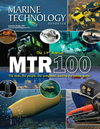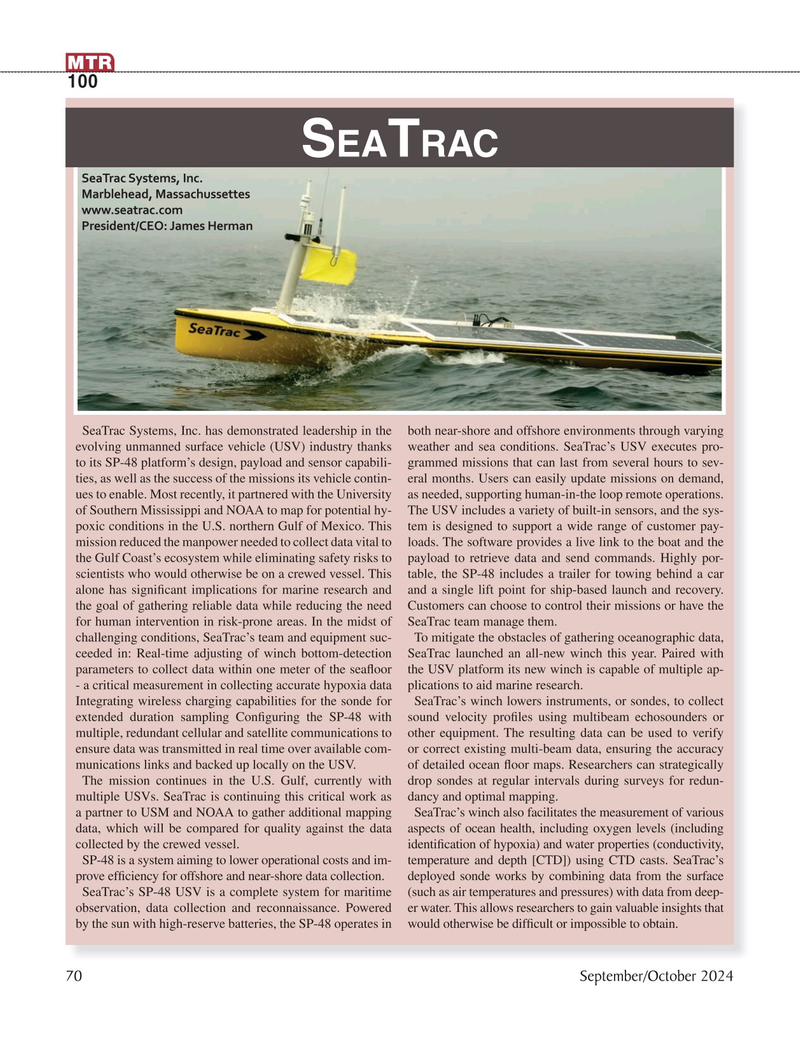
Page 70: of Marine Technology Magazine (September 2024)
Read this page in Pdf, Flash or Html5 edition of September 2024 Marine Technology Magazine
MTR 100
S TEA RAC
SeaTrac Systems, Inc.
Marblehead, Massachussettes www.seatrac.com
President/CEO: James Herman
SeaTrac Systems, Inc. has demonstrated leadership in the both near-shore and offshore environments through varying evolving unmanned surface vehicle (USV) industry thanks weather and sea conditions. SeaTrac’s USV executes pro- to its SP-48 platform’s design, payload and sensor capabili- grammed missions that can last from several hours to sev- ties, as well as the success of the missions its vehicle contin- eral months. Users can easily update missions on demand, ues to enable. Most recently, it partnered with the University as needed, supporting human-in-the loop remote operations. of Southern Mississippi and NOAA to map for potential hy- The USV includes a variety of built-in sensors, and the sys- poxic conditions in the U.S. northern Gulf of Mexico. This tem is designed to support a wide range of customer pay- mission reduced the manpower needed to collect data vital to loads. The software provides a live link to the boat and the the Gulf Coast’s ecosystem while eliminating safety risks to payload to retrieve data and send commands. Highly por- scientists who would otherwise be on a crewed vessel. This table, the SP-48 includes a trailer for towing behind a car alone has signi? cant implications for marine research and and a single lift point for ship-based launch and recovery. the goal of gathering reliable data while reducing the need Customers can choose to control their missions or have the for human intervention in risk-prone areas. In the midst of SeaTrac team manage them. challenging conditions, SeaTrac’s team and equipment suc- To mitigate the obstacles of gathering oceanographic data, ceeded in: Real-time adjusting of winch bottom-detection SeaTrac launched an all-new winch this year. Paired with parameters to collect data within one meter of the sea? oor the USV platform its new winch is capable of multiple ap- - a critical measurement in collecting accurate hypoxia data plications to aid marine research.
Integrating wireless charging capabilities for the sonde for SeaTrac’s winch lowers instruments, or sondes, to collect extended duration sampling Con? guring the SP-48 with sound velocity pro? les using multibeam echosounders or multiple, redundant cellular and satellite communications to other equipment. The resulting data can be used to verify ensure data was transmitted in real time over available com- or correct existing multi-beam data, ensuring the accuracy munications links and backed up locally on the USV. of detailed ocean ? oor maps. Researchers can strategically
The mission continues in the U.S. Gulf, currently with drop sondes at regular intervals during surveys for redun- multiple USVs. SeaTrac is continuing this critical work as dancy and optimal mapping. a partner to USM and NOAA to gather additional mapping SeaTrac’s winch also facilitates the measurement of various data, which will be compared for quality against the data aspects of ocean health, including oxygen levels (including collected by the crewed vessel. identi? cation of hypoxia) and water properties (conductivity,
SP-48 is a system aiming to lower operational costs and im- temperature and depth [CTD]) using CTD casts. SeaTrac’s prove ef? ciency for offshore and near-shore data collection. deployed sonde works by combining data from the surface
SeaTrac’s SP-48 USV is a complete system for maritime (such as air temperatures and pressures) with data from deep- observation, data collection and reconnaissance. Powered er water. This allows researchers to gain valuable insights that by the sun with high-reserve batteries, the SP-48 operates in would otherwise be dif? cult or impossible to obtain. 70 September/October 2024
MTR #7 (66-79).indd 70 10/8/2024 1:01:59 PM

 69
69

 71
71
